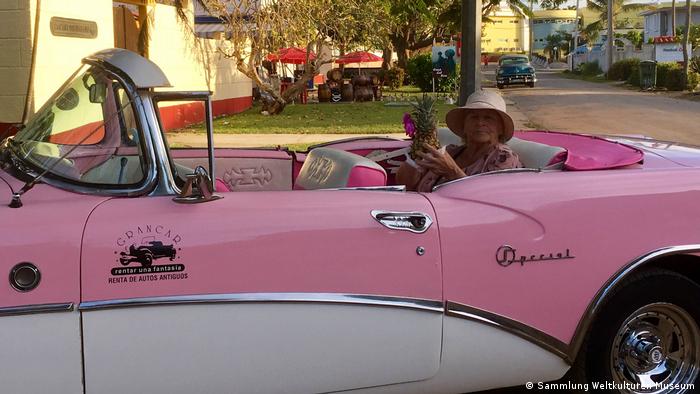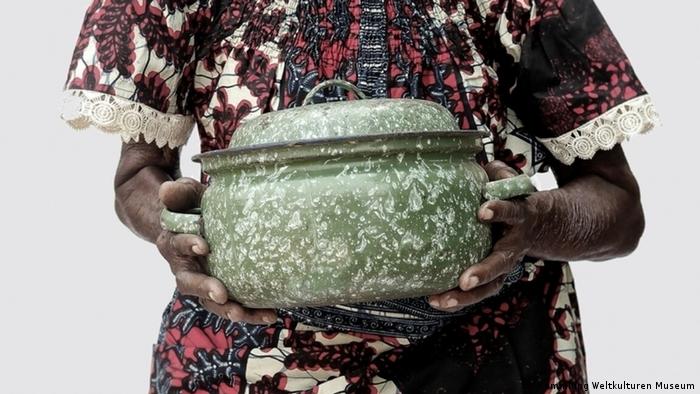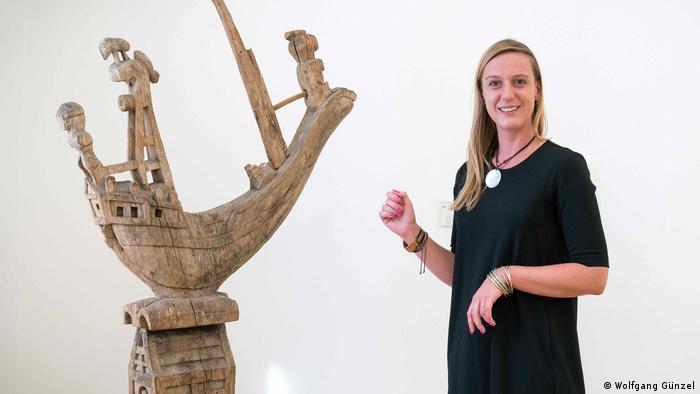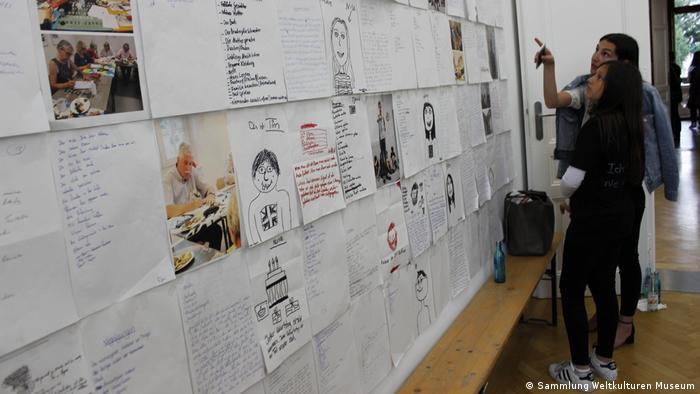Who’s where when old? Under the title, “Grey is the new pink” opened on aging, the Frankfurt weltkulturen Museum on Thursday (25.10.2018) an exhibition on the topic. The DW talked to curator Alice Pawlik.
-

“Grey is the new pink” – images of aging
Aging and impermanence
The exhibition displays have been designed to be works of 18 international artists, exhibits from the collections of the weltkulturen Museum plus new works created by the citizen participation project “Call for Content” for the people from around the world pictures on the theme of aging. Also this recording of the German photographer Axel mesh band.
-

“Grey is the new pink” – images of aging
“Enjoy the life”
The Frankfurt Heather photographed her 79-year-old Granny in a vintage car on Cuba. The photo with the title “enjoy The life” of 2017 is one of the more than 300 works, with which people from all over the world on the “Call for Content” in responded. From curator Alice Pawlik a visual answer to the question “How do you see the age was looking for?”.
-

“Grey is the new pink” – images of aging
“Interdependence”
Also, the photographer Lia Laukant has not contributed with your image is a visual commentary on the idea of growing old. “Merge” shows striking how closely and indissolubly the generation sequence. An individually stamped snapshot of aging.
-

“Grey is the new pink” – images of aging
Love, Sex and tenderness
Sex and tenderness in old age – so far, almost a taboo. That people can fall in love beyond the 60, and a need for tenderness and intimacy, documenting Jess T. Dugan and Vanessa Fabbre in their series “To Survive on This Shore”. The American artists portray older Transgender people and people with non-binary gender identity with their intimate thoughts.
-

“Grey is the new pink” – images of aging
What is the age?
Even if the world biologically visible processes as a sign of age to apply,
each culture in the determination of the age of their own species. A generally valid Definition does not exist. “Big Man” is a photograph from the collection of the Museum – and an answer to the question “Who is where and when old?” The picture was taken by Peter Beltjens 1950-55 in the province of Simbu in Papua new Guinea.
-

“Grey is the new pink” – images of aging
Aging in Dignity and beauty
This “Older woman from Bolivia” has been captured by an unknown photographer, 1969 in South America. The figure demonstrates that in all societies, is trying to stay young as long as possible, because in the age of greater risk of Contracting an Illness and the death is getting closer. Many of the photographs in the Department of “Visual anthropology” are ancient, yet active people in Dignity and beauty.
-

“Grey is the new pink” – images of aging
Families-love in the age
What is the role of love and tenderness within your own family play, shows the photographic series “L’essentiel est invisible pour les yeux” (“The Key is for
the eyes of the invisible”, 2014) by Ishola Akpo Benin. The family in old age – this is an issue between fear and Confidence, connected with many different aspects.
-

“Grey is the new pink” – images of aging
The wisdom of the tiger men
Lars Krutak has photographed in many journeys, the Nagas in India and Myanmar, in 2010, the Konyak Naga. The warriors are recognized by their fearsome Tattoos – a visual language, a mastery of only the Older men, most of whom are over eighty. The Knowledge of the powerful spiritual forces that summon you with your Tattoos, could be extinct with them.
-

“Grey is the new pink” – images of aging
Aging as a Lifestyle
Why do you want to work young people are actually becoming older and older younger? New images of old Age are on the rise – Instagram-Alt-Stars as the Berlin Hipster Günther Krabbenhöft (74) and Britt Kanja (67) the obvious. The Israeli artist Naama Attias presents her photographic series “Ain’t Nothing Wrong with being Beautiful” (2016) images of old Age on the head.
Author: Sabine Peschel
-

“Grey is the new pink” – images of aging
Aging and impermanence
The exhibition displays have been designed to be works of 18 international artists, exhibits from the collections of the weltkulturen Museum plus new works created by the citizen participation project “Call for Content” for the people from around the world pictures on the theme of aging. Also this recording of the German photographer Axel mesh band.
-

“Grey is the new pink” – images of aging
“Enjoy the life”
The Frankfurt Heather photographed her 79-year-old Granny in a vintage car on Cuba. The photo with the title “enjoy The life” of 2017 is one of the more than 300 works, with which people from all over the world on the “Call for Content” in responded. From curator Alice Pawlik a visual answer to the question “How do you see the age was looking for?”.
-

“Grey is the new pink” – images of aging
“Interdependence”
Also, the photographer Lia Laukant has not contributed with your image is a visual commentary on the idea of growing old. “Merge” shows striking how closely and indissolubly the generation sequence. An individually stamped snapshot of aging.
-

“Grey is the new pink” – images of aging
Love, Sex and tenderness
Sex and tenderness in old age – so far, almost a taboo. That people can fall in love beyond the 60, and a need for tenderness and intimacy, documenting Jess T. Dugan and Vanessa Fabbre in their series “To Survive on This Shore”. The American artists portray older Transgender people and people with non-binary gender identity with their intimate thoughts.
-

“Grey is the new pink” – images of aging
What is the age?
Even if the world biologically visible processes as a sign of age to apply,
each culture in the determination of the age of their own species. A generally valid Definition does not exist. “Big Man” is a photograph from the collection of the Museum – and an answer to the question “Who is where and when old?” The picture was taken by Peter Beltjens 1950-55 in the province of Simbu in Papua new Guinea.
-

“Grey is the new pink” – images of aging
Aging in Dignity and beauty
This “Older woman from Bolivia” has been captured by an unknown photographer, 1969 in South America. The figure demonstrates that in all societies, is trying to stay young as long as possible, because in the age of greater risk of Contracting an Illness and the death is getting closer. Many of the photographs in the Department of “Visual anthropology” are ancient, yet active people in Dignity and beauty.
-

“Grey is the new pink” – images of aging
Families-love in the age
What is the role of love and tenderness within your own family play, shows the photographic series “L’essentiel est invisible pour les yeux” (“The Key is for
the eyes of the invisible”, 2014) by Ishola Akpo Benin. The family in old age – this is an issue between fear and Confidence, connected with many different aspects.
-

“Grey is the new pink” – images of aging
The wisdom of the tiger men
Lars Krutak has photographed in many journeys, the Nagas in India and Myanmar, in 2010, the Konyak Naga. The warriors are recognized by their fearsome Tattoos – a visual language, a mastery of only the Older men, most of whom are over eighty. The Knowledge of the powerful spiritual forces that summon you with your Tattoos, could be extinct with them.
-

“Grey is the new pink” – images of aging
Aging as a Lifestyle
Why do you want to work young people are actually becoming older and older younger? New images of old Age are on the rise – Instagram-Alt-Stars as the Berlin Hipster Günther Krabbenhöft (74) and Britt Kanja (67) the obvious. The Israeli artist Naama Attias presents her photographic series “Ain’t Nothing Wrong with being Beautiful” (2016) images of old Age on the head.
Author: Sabine Peschel
DW: Every person ages. Why does it need a exhibition to this topic?
Alice Pawlik: Because the age is always changing. The effects of biological aging, which runs quite the same around the world, but every Generation in every culture ages differently. The desires and needs change. And many other aspects – medical, technological, or cultural – that the age is expressed in different cultures of the world differ.
Of course, it depends also on how the society sees the aging. It has a better feel, an affirmation of Life and joy at the age when you will not be stigmatized by the society.
You have worked long with the theme. Have you found a society in which there is a particularly good ageing?
No, and I don’t want to find. The exhibition is not intended to be, a Region or a society as Ideal. The subtitle of the exhibition is “a snapshot of ageing”. It is not a question to find definitions or explanations, but rather to the complexity.
Why is the world cultures Museum in favour of a more appropriate place?
We have in our Museum a collection from all regions of the world. In Ethnology, it is always so that you try and put a oscillating process between the so-called “other” and themselves.
We want as many perspectives as possible, and then our visit to present to visitors. As a visitor, you walk through the exhibition and find out all the possibilities, what is the meaning of the topic of aging. Where you might learn new perspectives. What then inspires you to Think and perhaps to Act.
I am about the title of stumbled upon that is based on a Streaming-series: “Grey is the new pink”. An exhibition on ageing, in need of such a time-bound and also a bit of a lurid title?
As lurid I don’t feel him. Rather, it was to convey that the exhibition brings a change in perspective that it’s not something you can see on the first glance immediately.

Alice Pawlik is responsible for “Grey is the new pink”.
How was the exhibition, was curated by, what is seen now?
What we find now, is a Combination of many different moments and positions. Us was not important that we highlight only one Position – be it the artistic or the scientific. This meant that we have also initiated a larger, world-scale citizen participation. We have called the people: Send us your picture of aging! This could be photographs, sketches, drawings, small movies or just an expression. Basically, a visual answer to the question: How do you see the age?
Have you used social media or direct contacts?
We had about 5000 addresses to which we addressed our question. We have a total of 350 submissions. The Whole thing was created in three months, from January to March of this year. From the submissions, we have selected 165 positions. Together with photographs from the image archive of Visual anthropology, we have brought them together in a large Installation. This is a Central part of our exhibition. Because we want to start with our image, with our ideas, and then through a variety of perspectives in the following areas to expand.
Perspectives that you selected or as a curator have researched?
The exhibition consists of multi-perspective: artists have dealt with the respective subjects, but also people at the intersection of art and Ethnology. For example, the ethnologist Lars Krutaks from the USA with the practice of tattooing. He travels the world and makes stunning photos.
We have also worked with young students, the particular prototypes have been developed, also on the topic of Medical Design: products that can help the elderly or sick people, maybe in the future.

The exhibition also presents the results of the workshop “text designer”.
You have also done something with fairy tales. It makes you think more young people. What fairy tales have to do with aging?
Now, the children of the older generations read Yes most of the time. This is also a part of the knowledge transfer from the older Generation to the Younger. Because in the exhibition, we not only consider the life phase of old age, but also the process of aging. In today’s reality we have to deal with many of the digital processes. How does, for example, on the transmission of Knowledge, if we can now ask Google and Wikipedia? How is the authority of the older people?
And Also older people to read in part now by the Tablet fairy tales before, and no longer from the book. Also very many older people in the social media now: The Instagram account of Berlin’s two “Senior Influencer” Günther Krabbenhöft (geb. 1945), and Britt Kanja (born in. 1951), which we will present in the exhibition, have an incredible number of Followers and many Likes, and often also by young people. Maybe respect for the age expresses itself today through a lot of Likes, clicks and Followers.
Who do you want to reach with your exhibit?
Quite simply, all. Every fourth child born today in Germany, about 100 years old, so the prognosis is, anyway. As a society, we should take this scenario and prepare, not only socially and politically, but also culturally and in the relationship of the generations to each other. For this reason, this exhibition is intended really for all. We also have topics such as Instagram, or the fairy-tale grandmother Helga, who reads every Friday evening at 20 o’clock on YouTube fairy tales and over 200,000 Followers and eight million clicks. Such things are also quite interesting for young people.
The ethnologist Alice Pawlik, aging is responsible for the exhibition around the theme. As a Curator of Visual anthropology, she is head of the imaging Department, Film and media of the world cultures Museum.
The exhibition, “Grey is the new pink” runs from 26.10.2018 to 01.09.2019.
The interview was conducted by Sabine Peschel.










